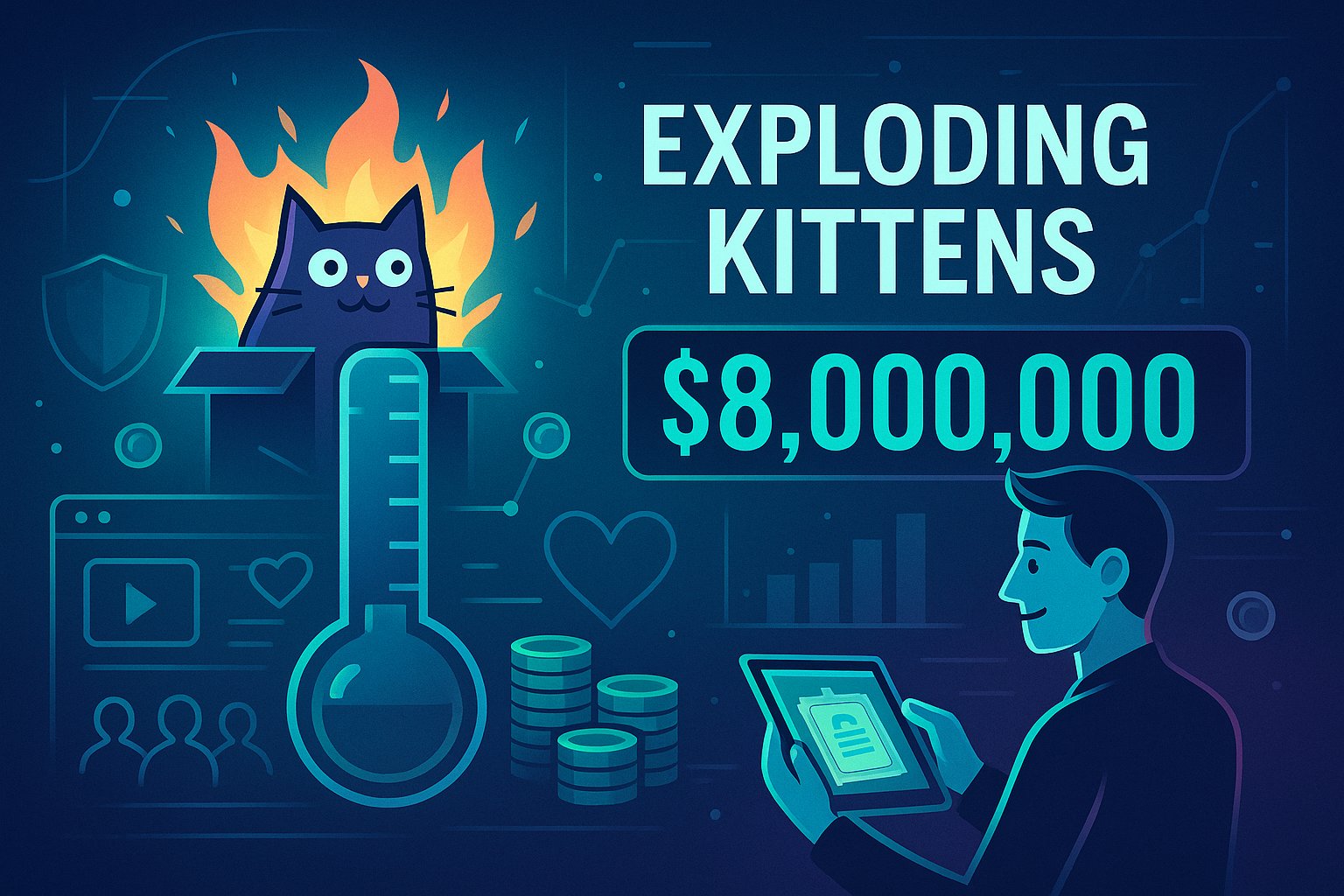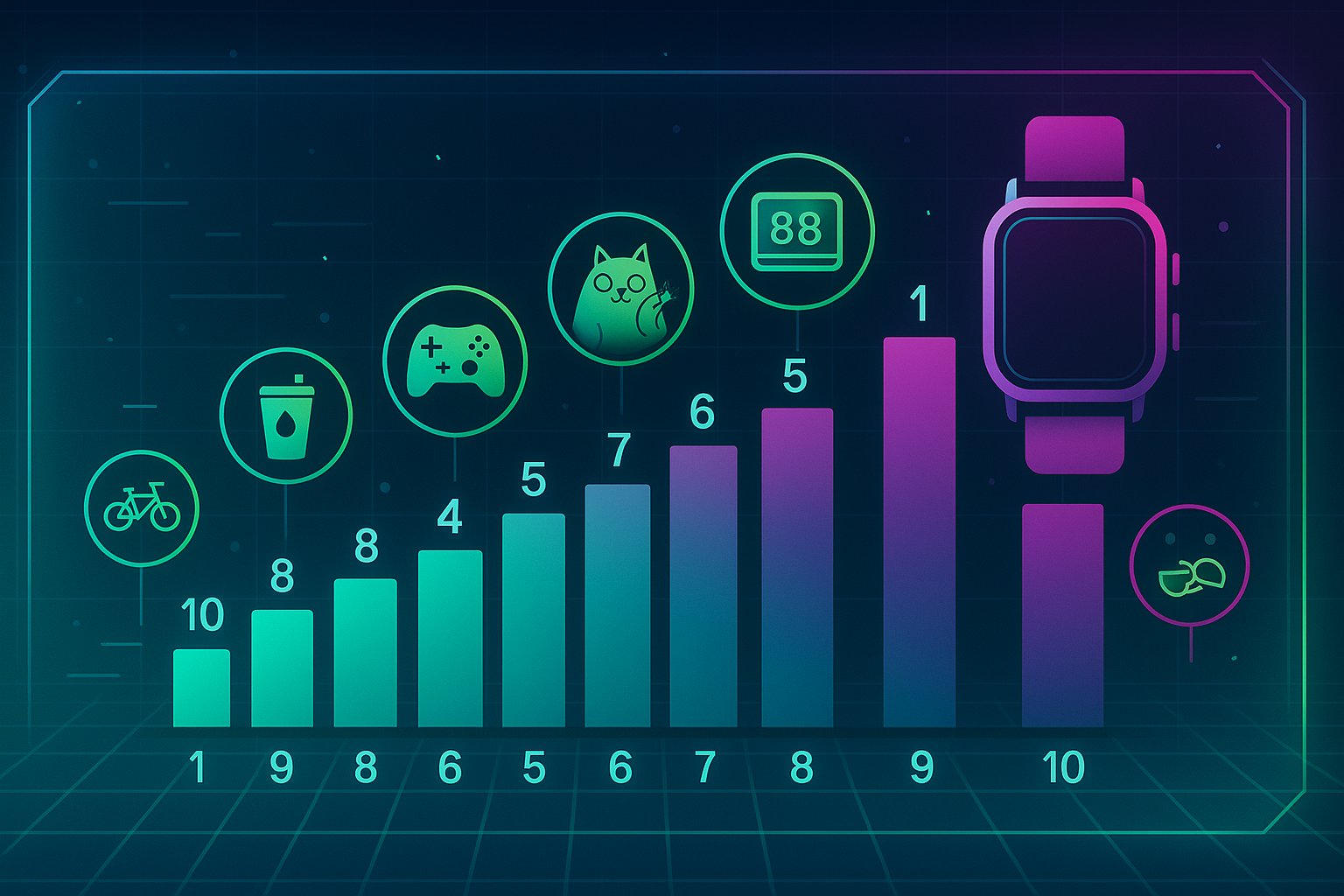How a Card Game Captured the Internet’s Imagination
In early 2015, a seemingly simple card game upended the crowdfunding world and captured the collective imagination of gamers, internet communities, and Kickstarter enthusiasts alike. Exploding Kittens, conceived by Elan Lee, Matthew Inman (the creator behind The Oatmeal), and Shane Small, set out not merely to fund a tabletop project but to launch a cultural phenomenon. Before the campaign went live, the team knew they had a playful concept—cute, cartoonish kittens paired with high-stakes, Russian-roulette–style gameplay—but they harbored no inkling of the lightning bolt that would strike when their Kickstarter page debuted. Within hours, pledges surged past their initial $10,000 target, ultimately dwarfing it by an astonishing margin. By the campaign’s close, Exploding Kittens had raised over $8.7 million from nearly 220,000 backers, cementing its status as the most backed Kickstarter project of its time.
This meteoric rise was no accident. It stemmed from a masterful combination of design simplicity, iconic artwork, strategic marketing, and genuine respect for community engagement. Whereas many tabletop projects flounder amid niche audiences and modest backing, Exploding Kittens tapped into universal themes: humor, suspense, and the unexpected delight of feline mischief. The campaign page itself burst with The Oatmeal’s signature illustrations—quirky cats with wide-eyed expressions, bundled with playful copy that balanced vivid explanations of game mechanics with tongue-in-cheek humor. Every element, from the tiered reward descriptions to the update posts, worked in concert to build anticipation, sustain momentum, and keep backers invested—not just financially, but emotionally. Exploding Kittens emerged in an era when Kickstarter was rapidly evolving from a novelty funding platform into a launchpad for mainstream entertainment. The game’s success demonstrated how a well-executed crowdfunding strategy could elevate a modest creative endeavor into a worldwide brand. It showcased the power of combining a strong narrative, distinctive visuals, and transparent communication to galvanize a diverse, enthusiastic backer community. In the sections that follow, we will dissect the journey of Exploding Kittens from concept to legend, exploring the creative process, campaign tactics, stretch goals, fulfillment challenges, and the lasting impact on both the tabletop industry and crowdfunding best practices.
The Creative Minds Behind Exploding Kittens
The story of Exploding Kittens begins with a quartet of creative individuals who each brought a unique strength to the project. Elan Lee, known for his work on blockbuster titles such as Xbox’s Alan Wake and the alternate reality game phenomenon “I Love Bees,” contributed deep expertise in game design and narrative orchestration. Matthew Inman, the irrepressible cartoonist behind The Oatmeal webcomic, infused the game with his distinctive art style and sense of humor. Shane Small, an experienced tabletop designer with credits on popular games, bridged the gap between digital and physical game mechanics, ensuring that Exploding Kittens would play smoothly on the kitchen table as well as capture smiles online.
Their collaboration was born out of mutual respect and complementary skills. Lee had conceived a prototype called “Bomb Squad,” reimagined in cat form under Inman’s pen, while Small refined the gameplay to balance randomness, strategy, and player interaction. Inman’s webcomic served as an organic marketing channel: he teased the project through his site’s millions of visitors, collected initial feedback, and seeded anticipation. By the time the Kickstarter campaign launched, the founders had melded their talents into a cohesive whole—a game that was simple to learn, quick to play, and endlessly memeable thanks to its absurd kitty explosions.
This creative synergy extended beyond the core team. Playtesters from Inman’s community provided real-world insights into card balance and house-rule variants, shaping final tweaks. Inman’s comic readers, accustomed to interactive content, felt personally invested. Lee’s network within the gaming industry generated early press interest. The blending of Silicon Valley game design chops, viral cartoon artistry, and hands-on tabletop know-how produced a formula that would resonate across demographic lines—from casual card players to hardcore hobbyists to followers of The Oatmeal’s online humor.
Unveiling the Game: Mechanics and Quirky Artistry
At first glance, Exploding Kittens appears deceptively straightforward: a deck of illustrated cards, each bearing instructions that range from “Skip” to “See the Future” to “Nope,” all building toward the eponymous “Exploding Kitten” card that triggers elimination. Players take turns drawing cards, hoping to avoid a kitten that will “explode” unless diffused by a rare “Defuse” card, replete with Inman’s endearing cat-and-sausage imagery. Yet beneath the simplicity lies a carefully calibrated tension. The blend of chance (drawing from the deck) and strategy (playing action cards at opportune moments) keeps players engaged and laughter abundant.
Inman’s artwork transcended mere decoration; it became the campaign’s lingua franca. Each card’s iconography, from the purring feline on a cupcake to the startling gaze of a cat astride a bomb, conveyed narrative tone instantly. The stark, high-contrast color scheme—often just black, white, and a pop of color—ensured legibility in low-light gaming settings and strengthened shelf presence. Moreover, the thematic consistency—every card aligned with the humorous, slightly macabre kitten motif—bolstered brand identity. Backers and media outlets quickly shared images, memes, and gifs of the cards, turning the game’s visual language into viral currency.
Mechanically, Exploding Kittens occupied a sweet spot between family-friendly simplicity and competitive edge. Rounds lasted between 5 and 15 minutes, making it suitable for casual gatherings as well as convention panels and livestreamed playthroughs. The rules were so accessible that the campaign page included a single-page PDF “Quick Start” guide, supplemented by a tongue-in-cheek video tutorial. By eliminating common entry barriers—complex setups, hefty rulebooks—the team ensured that both Kickstarter-savvy gamers and newcomers could dive right in, pledge with confidence, and share the experience with their peers.
Brewing the Perfect Kickstarter Pitch
When the Exploding Kittens Kickstarter campaign went live in February 2015, its creators were prepared to harness every facet of the platform’s capabilities. The campaign page opened with a dynamic video featuring Lee, Inman, and Small introducing themselves, showcasing prototypes, and announcing the $10,000 funding goal. The pitch emphasized transparency: they outlined manufacturing partners, production timelines, estimated shipping dates, and potential risks. This level of openness, uncommon at the time, fostered trust and quelled common backer fears about missing deadlines or receiving subpar components. Throughout the page, backers found a narrative structure that mirrored the game’s own design philosophy—concise, engaging, and infused with humour. The story moved from problem statement (“Tabletop games can be clunky and pretentious”) to solution (“Exploding Kittens: a swift, hilarious card game for everyone”) with smooth transitions. Reward tiers were clearly delineated: the base game, deluxe editions with exclusive promo cards, and premium bundles featuring the founders’ signatures and custom-themed merchandise. Each tier included shipping estimates by region, eliminating the confusion that often plagued international backers on other campaigns.
Stretch goals, introduced as the campaign zoomed past its initial goal, were presented as community-driven milestones rather than arbitrary incentives. As each unlocked tier arrived—additional card packs, illustrated “taches” of cats, absurdly cute magnets—backers celebrated as though they themselves had designed those add-ons. By framing stretch goals as gifts from the creators back to supporters, Exploding Kittens cultivated a virtuous cycle: backers shared more, which unlocked more content, which fueled more pledges, and so on.
Community Engagement and Viral Marketing
Perhaps the most pioneering aspect of the Exploding Kittens campaign was its masterful deployment of community engagement and viral outreach. The team understood that Kickstarter was not just a funding platform but a social network fueled by shareable content. They released daily updates that went beyond simple pledge tallies to include anecdotes, behind-the-scenes videos, and even offbeat “Office Cat Antics” clip reels. Each update reinforced a sense of intimacy—backers felt as though they were touring the design studio alongside the creators. Simultaneously, Exploding Kittens leveraged social media in innovative ways. Twitter polls determined the color palette for new cards, Facebook comments informed stretch-goal priorities, and Instagram served as a gallery for user-submitted fan art. Their use of humor—puns, absurdist cat jokes, playful jabs at competing card games—kept the campaign’s tone light and approachable. Influencers and gaming personalities who received early prototype copies shared unboxing videos that quickly racked up views, while mainstream media outlets featured the campaign in “Kickstarter Watch” columns, driving waves of organic traffic. The network effect was palpable. As backers shared their support on social channels, their followers clicked through, joined the campaign, and added their pledges. Within days, Exploding Kittens had escaped the confines of tabletop gaming blogs and penetrated tech and culture publications, from Gizmodo to The New York Times. The campaign’s viral coefficient—measuring how many new backers each existing backer brought in—crushed industry averages. By campaign end, backers hailed from over 100 countries, creating a truly global phenomenon.
Unlocking Stretch Goals and Reward Tiers
As Exploding Kittens‘ pledge total climbed into the millions, the team unveiled a series of ambitious stretch goals designed to keep the campaign dynamic and engaging. These goals ranged from additional card expansions—introducing new mechanics such as “Zombie Kittens” and “Imploding Kittens”—to deluxe physical add-ons like illustrated metal tins, embroidered patches, and LED-lit card sleeves. Each stretch goal was accompanied by a vivid mock-up or prototype demonstration, reinforcing backers’ belief that these enhancements were not mere placeholders but real, deliverable products.
Reward tiers evolved in tandem. Early-bird backers who pledged within the first 24 hours received exclusive promotional cards; subsequent backers could secure “Super Deluxe” bundles with signed copies and limited-edition prints. Despite the dizzying variety, the structure remained clear: each tier offered tangible upgrades, well-communicated shipping timelines, and concise pricing. This clarity prevented common pitfalls—confusion over shipping fees or reward contents—that have marred other campaigns. By the time Exploding Kittens shattered Kickstarter records, backers were not only invested financially but emotionally, eagerly awaiting their stretch-goal surprises and proudly bragging about their reward tier status.
Overcoming Fulfillment Challenges
Raising nearly $9 million introduced logistical complexities that few tabletop creators had faced. The team needed to coordinate mass production, quality control, packaging design, and global distribution on an unprecedented scale. They partnered with experienced manufacturers who handled high-volume print runs of both standard and stretch-goal cards, while a fulfillment center specialized in bundling multiple-tier rewards and managing international shipping regulations.
Throughout the process, Exploding Kittens maintained its signature transparency. Backers received regular production updates complete with factory photos, sample quality checks, and shipping container manifests. When a supplier delivered artwork with minor color discrepancies, the team promptly reported the issue, demonstrated their corrective actions, and reiterated the revised shipping schedule. This candor defused potential frustration and preserved goodwill. By the end of 2016, over 95 percent of backers had their complete orders in hand—a remarkable achievement given the scale and novelty of the endeavor.
Beyond the Kickstarter: Building a Sustainable Brand
While the crowdfunding campaign was a landmark success in its own right, the creators of Exploding Kittens understood that sustaining momentum required evolving beyond Kickstarter. They launched a dedicated online store, offering the original game alongside newly developed expansions and exclusive accessories. Retail partnerships placed Exploding Kittens on shelves in major chain stores, hobby shops, and big-box retailers, broadening audience reach.
The brand’s expansion strategy included mobile and digital adaptations—an iOS and Android app that replicated the card game experience with online matchmaking and AI opponents. This digital pivot tapped into casual gaming audiences, introduced the brand to non-tabletop gamers, and provided a new revenue stream. Meanwhile, regular release of expansions—such as “Streaking Kittens” and “Barking Kittens”—kept the community engaged and provided fresh content for both physical and digital platforms.
Lessons from a Crowdfunding Masterclass
The Exploding Kittens story offers a blueprint for crowdfunding success that transcends any single campaign. First, a compelling, easily understood concept paired with distinctive artwork can break through the noise of innumerable Kickstarter projects. Second, transparent communication—about risks, timelines, and challenges—fosters deep trust, turning backers into advocates even when obstacles arise. Third, community engagement through both structured updates and spontaneous social media interactions creates a viral engine that fuels sustained pledges.
Moreover, strategic use of stretch goals and tiered rewards can maintain excitement well beyond the initial funding surge, while thoughtful fulfillment planning ensures that the post-campaign experience upholds the promise of the pitch. Finally, evolving the brand through digital adaptations, retail partnerships, and ongoing expansions transforms a one-off success into a lasting business ecosystem. These principles, demonstrated so vividly by Exploding Kittens, remain essential for any creator looking to harness crowdfunding’s full potential.
The Enduring Legacy of Exploding Kittens
Exploding Kittens stands as one of the crowning achievements of crowdfunding history—a quirky card game that leveraged humor, art, and community to raise unprecedented funds and redefine what tabletop projects could achieve on Kickstarter. Its legacy endures in the countless projects that now incorporate similar engagement strategies, narrative styles, and fulfillment transparency. Entrepreneurs and gamers continue to look to Exploding Kittens as proof that grassroots creativity, when paired with disciplined execution and authentic connection, can spark global movements.
As we reflect on the campaign’s lessons, one truth emerges: successful crowdfunding is as much about people as it is about products. By investing in community, embracing transparency, and delivering on promises—humble or grand—creators can forge lasting bonds that transcend the confines of any single campaign. Exploding Kittens exemplified this ethos, transforming a playful concept into a crowdfunding legend and leaving an indelible mark on the worlds of gaming, crowdfunding, and creative entrepreneurship.




